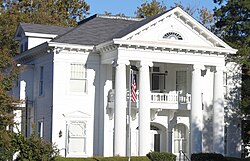The Governor Luther Hall House is a historic residence located at 1515 Jackson Street in Monroe, Ouachita Parish, Louisiana. It was constructed in 1906 by its owner, Luther E. Hall, who would later serve as the 35th Governor of Louisiana.
Gov. Luther Hall House | |
 Governor Luther Hall House in 2014 | |
 | |
| Location | 1515 Jackson Street, Monroe, Ouachita Parish, Louisiana |
|---|---|
| Coordinates | 32°29′N 92°07′W / 32.49°N 92.11°W |
| Built | 1906 |
| Architectural style | Colonial Revival and Queen Anne Revival |
| NRHP reference No. | 79001079 |
| Added to NRHP | May 7, 1979 |
History edit
The Governor Luther Hall House has historical significance, closely associated with its owner, Luther Hall. Construction of the residence began in 1906, coinciding with Luther Hall's relocation to Monroe, Louisiana. Luther Hall was a prominent figure in Louisiana's legal and political landscape, having served as an appellate judge.[1]
Luther Hall and his family resided in the house until his inauguration as the 35th Governor of Louisiana in 1912. In 1919, the property changed ownership, marking the beginning of several transitions. Ultimately, in 1946, the Young Women's Christian Organization of Monroe acquired the property.[2]
Today, the Governor Luther Hall House serves as the administrative offices of The Wellspring, a non-profit organization dedicated to providing community services.
Architecture edit
Source:[2]
The Governor Luther Hall House is an example of early 20th-century architectural eclecticism, combining elements from the Georgian Revival and Queen Anne Revival styles, characteristic of the era's design trends.[3]
The front facade of the house is adorned with four Ionic wooden columns supporting an ornate entablature. The entablature features intricate detail and medallion ornamentation, while the eaves display bracketed detailing. At the center of the facade is a fan lighted central window, flanked by detailed cornices that encircle the entire structure.
This central motif is echoed in the rear and on each side of the roofline, creating a truncated pedimented pyramidal roof. The sides of the roof feature louvered dormers, adding to the overall architectural appeal.
One-story three-window bays extend on either side of the first-floor dining room and rear double parlor, contributing to the house's symmetry.
The main portico, accessible via four concrete steps, serves as a focal point. The four columns rest on a concrete deck, added circa 1948, which extends around the side of the house to create a smaller side porch and entranceway connected to the first of the double parlors. This smaller porch features its own detailed and bracketed roof, supported by four small Ionic columns.
The entranceway itself is recessed behind three arches, with the central arch supported by square columns and two identical smaller arches supporting an extended upper wood blustered balcony. The central doorway is crowned by an elliptical fanlight, and sidelights extend from the fanlight down to recessed paneled wooden bases. Curved windows on either side of the central doorway further enhance the facade's aesthetics. Pilasters frame all windows and doors on the front of the house, with the lower-floor windows topped by pedimented entablatures. Unique corner boards articulate the clapboard structure, reminiscent of pilasters, adding an architectural feature to the exterior.
References edit
- ^ "NPGallery Asset Detail". npgallery.nps.gov. Archived from the original on 2023-08-27. Retrieved 2023-09-09.
- ^ a b "About us - The Wellspring". Archived from the original on 2023-07-05. Retrieved 2023-09-09.
- ^ Dawson, Joseph G., ed. (1990). The Louisiana governors: from Iberville to Edwards. Baton Rouge u.a: Louisiana State University Press. ISBN 978-0-8071-1527-5.